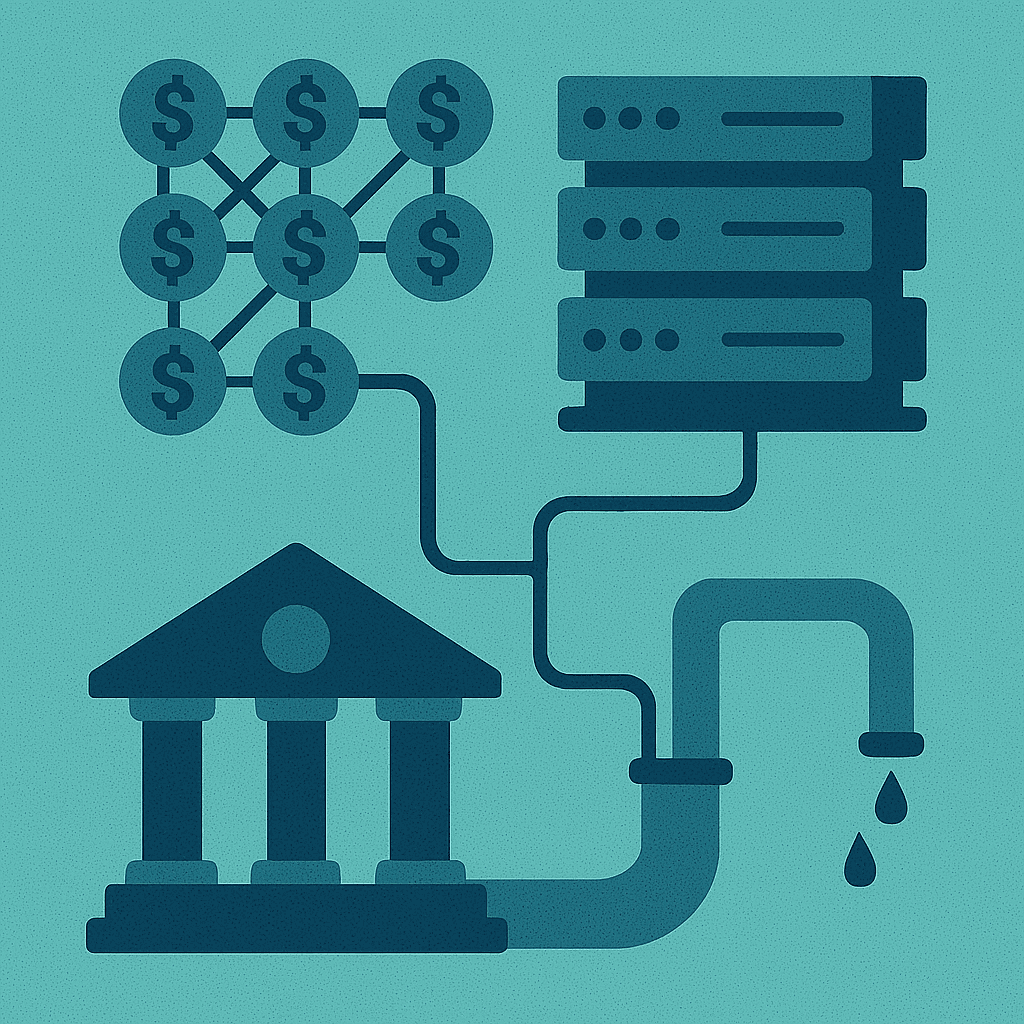The crypto banking revolution isn't coming, it's here. With stablecoin transaction volumes reaching $27.6 trillion in 2024, surpassing the combined volume of Mastercard and Visa by 7.68%, and the GENIUS Act passing the Senate, traditional banks can no longer afford to sit on the sidelines.
For financial institutions wondering how to enter this space, the question isn't whether to embrace crypto banking infrastructure, it's how to do it right. The technical requirements are complex, the regulatory landscape is evolving rapidly, and the implementation challenges are substantial. But here's the critical insight: banks don't need to build everything from scratch.
The New Regulatory Reality: GENIUS Act Creates Clear Framework
The GENIUS Act, which passed the Senate with bipartisan support on June 17, 2025, establishes the first federal regulatory framework for stablecoins. This landmark legislation creates both opportunities and constraints for traditional banks:
What Banks Can Now Do Under GENIUS Act
Issue compliant stablecoins as subsidiaries of insured depository institutions
Provide custody and basic transfer services with 100% reserve backing requirements using U.S. dollars and short-term Treasuries
Integrate stablecoin infrastructure with traditional banking systems
What Banks Cannot Do: The Partnership Opportunity
The GENIUS Act includes important limitations that create natural partnership opportunities:
Banks are prohibited from offering yield directly on stablecoin balances
Complex programmable payment products fall outside traditional banking scope
DeFi yield strategies on behalf of clients remain restricted
This regulatory structure creates a natural specialization opportunity: banks handle compliance and custody, while specialized infrastructure providers enable the programmable layer that makes stablecoins truly useful for business operations.
Technical Infrastructure Requirements for Crypto Banking: Beyond Basic Custody
Implementing crypto payment rails requires far more than adding a digital wallet to existing systems. Banks need comprehensive DeFi infrastructure across multiple domains:
Blockchain Integration Layer
Node infrastructure: Direct connection to blockchain networks (primarily Ethereum, Solana, and Base for stablecoins)
Smart contract interfaces: APIs for interacting with DeFi protocols and programmable money
Multi-signature systems: Enterprise-grade key management and transaction authorization
Real-time monitoring: 24/7 blockchain transaction monitoring and failure detection
Compliance and Security Framework
Recent guidance from the FDIC and OCC clarifies that banks can engage in crypto activities without prior approval, provided they maintain adequate risk management. This includes:
AML/KYC Integration: Transaction monitoring, customer verification, and suspicious activity reporting specifically adapted for blockchain transactions
Travel Rule Compliance: On-chain metadata for cross-border payments exceeding $3,000
Sanctions Screening: Real-time OFAC compliance for wallet addresses and transaction flows
Cybersecurity Protocols: Protection against smart contract exploits, private key compromise, and blockchain-specific attack vectors
Operational Infrastructure for Stablecoin Business Banking
Liquidity Management: Real-time stablecoin treasury operations and reserve management
Settlement Systems: Integration with existing core banking systems for seamless fiat-crypto workflows
Customer Interface: User-friendly dashboards for business clients to manage crypto treasury management
Reporting Systems: Regulatory reporting tools adapted for digital asset transactions
The Staggering Complexity: Why Building Internal Crypto Infrastructure Is a Costly Mistake
Let's be frank about what internal development actually entails. Banks considering building crypto infrastructure in-house face a daunting reality:
Development Timeline and Costs
A comprehensive crypto banking platform requires 18-24 months of development with teams including:
Blockchain engineers ($200K+ annually each)
Smart contract developers ($180K+ annually each)
Crypto compliance specialists ($150K+ annually each)
DevOps engineers familiar with blockchain infrastructure ($170K+ annually each)
Total development costs typically exceed $15-25 million before launch, with ongoing operational costs of $3-5 million annually.
Technical Risks in DeFi Infrastructure
Smart contract vulnerabilities: Even audited contracts can contain exploits costing millions
Key management failures: Lost private keys mean permanently lost funds
Protocol risks: DeFi protocols can fail, affecting yield generation and liquidity
Scalability challenges: Blockchain networks experience congestion and varying fees
Regulatory Compliance Burden
Crypto businesses must navigate complex federal and state licensing requirements, with money transmitter licensing rules differing across states. Banks face additional layers:
State-by-state compliance variations for stablecoin business accounts
Evolving federal guidance from multiple agencies
Complex framework of overlapping and sometimes conflicting federal and state laws
The Strategic Partnership Advantage: Focus on Core Banking, Outsource Complexity
Smart banks are recognizing that crypto infrastructure is best provided through strategic partnerships. Here's why:
Speed to Market for Crypto Treasury Management
Instead of 18-24 months of development, banks can launch crypto services in 3-6 months through proven infrastructure providers. FV Bank's CEO Miles Paschini notes: "We're blazing the trail for a future where blockchain is just another payment rail", but that trail doesn't need to be blazed by every bank individually.
Risk Mitigation Through Specialized Infrastructure
Infrastructure partners absorb technical and operational risks:
Security: Specialized providers invest heavily in blockchain security
Compliance: Dedicated teams track evolving regulations
Technology updates: Automatic protocol upgrades and network improvements
Capital Efficiency for High-Yield Business Banking
Partnership models typically require minimal upfront investment compared to internal development. Banks can focus capital on their core competencies while accessing best-in-class crypto infrastructure for yield-generating business accounts.
Real-World Success Stories: Banks Partnering for Crypto Success
JPMorgan's Kinexys Platform
JPMorgan leverages its Kinexys (formerly Onyx) blockchain platform for asset tokenization and digital asset management, while integrating JPM Coin for real-time institutional payments. The bank didn't build everything internally, it focused on institutional-grade infrastructure while partnering for broader ecosystem connectivity.
FV Bank's Integrated Approach
FV Bank integrates PayPal USD (PYUSD), Circle's USDC, and Tether's USDT for direct deposits and outbound payments, demonstrating how banks can offer comprehensive stablecoin services through strategic partnerships rather than building competing infrastructure.
RebelFi: The DeFi Infrastructure Partner Banks Need
This is where platforms like RebelFi become invaluable for traditional banks entering the stablecoin business banking space. Rather than building complex programmable payment infrastructure internally, banks can partner with specialized providers to offer cutting-edge services:
What RebelFi Brings to Bank Partnerships
Instant yield infrastructure: Every stablecoin deposit begins earning yield immediately through DeFi integration
Programmable payment logic: Smart escrows, conditional releases, and automated workflows for crypto treasury management
Compliance-ready systems: Built-in Travel Rule compliance and audit trails
Enterprise security: Non-custodial architecture with institutional-grade risk management
The Partnership Model for DeFi Business Banking
Banks focus on what they do best - customer relationships, compliance, and traditional banking services—while RebelFi provides the programmable layer that transforms simple stablecoin transfers into powerful business tools.
For example, a business banking client could:
Receive payments in any cryptocurrency through the bank's interface
Automatically convert to stablecoins via RebelFi's infrastructure
Earn yield immediately on balances through integrated DeFi protocols
Automate workflows like payroll or vendor payments with programmable logic
Technical Integration: How Bank-Infrastructure Partnerships Work
API-First Architecture for Stablecoin Infrastructure
Modern crypto infrastructure providers offer RESTful APIs that integrate seamlessly with existing banking systems:
Bank Core System → Infrastructure API → Blockchain Networks ↓ Customer Dashboard ← Real-time Updates ← Transaction Monitoring
White-Label Solutions for Crypto Business Banking
Infrastructure partners provide branded solutions that appear native to the bank's customer experience while leveraging specialized backend systems for DeFi yield optimization and stablecoin treasury management.
Compliance Integration for Digital Asset Banking
Automated reporting: Transaction data flows directly into bank compliance systems
Risk scoring: Real-time assessment of cryptocurrency transactions
Audit trails: Complete transaction history for regulatory examination
Risk Management: How Partnerships Reduce Bank Exposure
Operational Risk Reduction in DeFi Infrastructure
No smart contract exposure: Infrastructure partners assume technical risks
Professional security: Dedicated teams monitoring for threats 24/7
Insurance coverage: Many providers carry specialized crypto insurance
Regulatory Risk Mitigation for Stablecoin Business Accounts
Compliance expertise: Partners stay current with evolving GENIUS Act regulations
Licensing coverage: Infrastructure providers maintain necessary state and federal licenses
Audit readiness: Professional-grade documentation and reporting systems
Financial Risk Management for Crypto Treasury Management
No development costs: Avoid massive upfront technology investments
Predictable pricing: Partnership agreements with clear fee structures
Scalable economics: Costs align with transaction volume and growth
The Implementation Roadmap: From Partnership to Launch
Phase 1: Strategic Assessment (30 days)
Evaluate customer demand for crypto business banking services
Assess regulatory requirements in operating jurisdictions
Select infrastructure partner based on technical capabilities and compliance record
Phase 2: Integration Planning (60 days)
Design customer experience flows for stablecoin business accounts
Integrate APIs with existing banking systems
Develop staff training programs on crypto treasury management
Create marketing strategies around high-yield business banking
Phase 3: Pilot Launch (90 days)
Launch with select business customers seeking yield-generating accounts
Monitor transaction flows and customer feedback
Refine processes and address initial challenges
Prepare for broader rollout of DeFi-powered business banking
Phase 4: Scale and Expand (ongoing)
Expand to additional customer segments seeking crypto treasury management
Add new features through partner platform (programmable payments, automated workflows)
Monitor competitive landscape and regulatory changes
Optimize operations for efficiency and growth
Looking Ahead: The Future of Crypto Banking Infrastructure
With adoption standing at 53% globally and 87% technology readiness in key markets, the momentum toward crypto banking is undeniable. As the Federal Reserve Bank of Atlanta notes, "the future of stablecoins as a payment method is still unfolding, but as digital assets gain wider acceptance, their adoption could grow, potentially rivaling credit or debit cards".
Emerging Trends in Stablecoin Business Banking
Corporate stablecoins: Amazon and Walmart are reportedly exploring issuing their own stablecoins
Embedded DeFi: Integration of yield-generating protocols into traditional business banking products
Cross-border optimization: Stablecoins enabling instant international business payments
Programmable money: Smart contracts automating complex financial workflows for treasury management
Competitive Implications for Banks
Banks that delay crypto integration risk losing business customers to more innovative competitors. 53% of businesses already show adoption, with fast-moving organizations seeing stablecoins as both offensive and defensive strategy.
Market Demand: The Numbers Don't Lie
The stablecoin infrastructure market is experiencing unprecedented growth:
$27.6 trillion in stablecoin transfers in 2024, surpassing Visa and Mastercard combined
Monthly stablecoin transactions reached $110 million in 2024
Total stablecoin supply increased 28% year-over-year, reaching over $200 billion
Nearly 20% of Fortune 500 executives now consider on-chain initiatives strategic, up 47% year over year
These aren't speculative numbers, they represent real economic activity demanding banking infrastructure that can support programmable money and crypto treasury management.
The Bottom Line: Partner, Don't Build
The infrastructure behind crypto banking is complex, rapidly evolving, and requires specialized expertise that goes far beyond traditional banking technology. Smart banks are recognizing that partnerships with dedicated infrastructure providers offer the fastest, safest, and most cost-effective path to offering stablecoin business banking services.
The choice is clear: Spend 18+ months and $20+ million building internal crypto infrastructure that may be obsolete by launch, or partner with proven providers to launch comprehensive DeFi-powered business banking services in months, not years.
For traditional banks ready to embrace the future of digital payments and crypto treasury management, the infrastructure is ready. The regulations are clarifying under the GENIUS Act. The customer demand is proven with $27.6 trillion in transaction volume.
The question isn't whether crypto banking will transform the financial industry, it's whether your bank will lead the transformation or follow from behind.
Ready to explore how your bank can integrate crypto payment infrastructure and offer high-yield stablecoin business accounts without the complexity of building internally? The specialized providers are ready to partner with forward-thinking institutions that want to offer cutting-edge DeFi-powered services while focusing on their core banking strengths.



